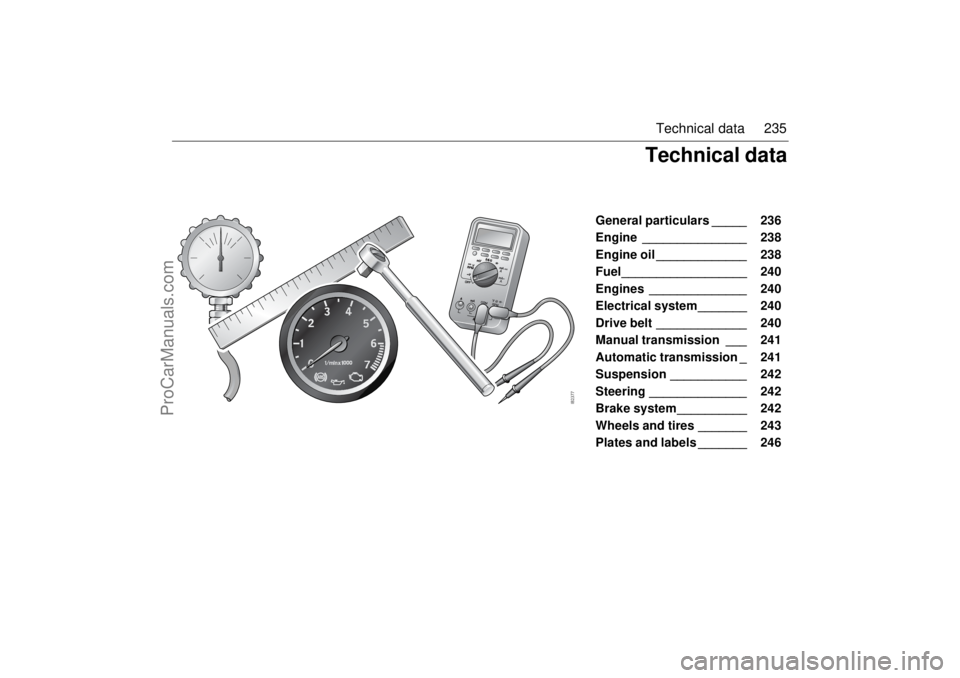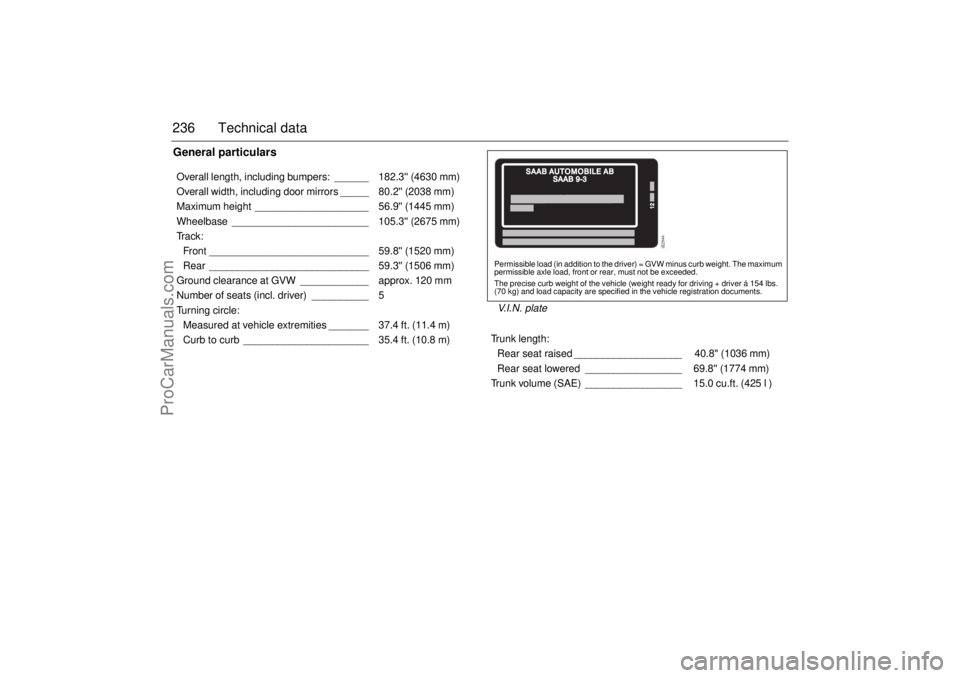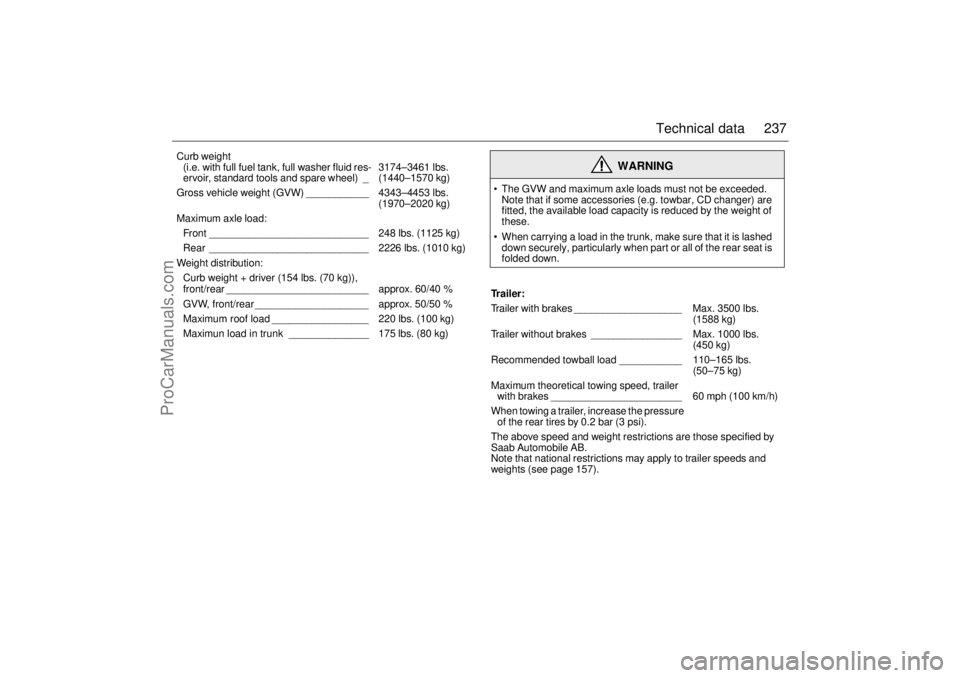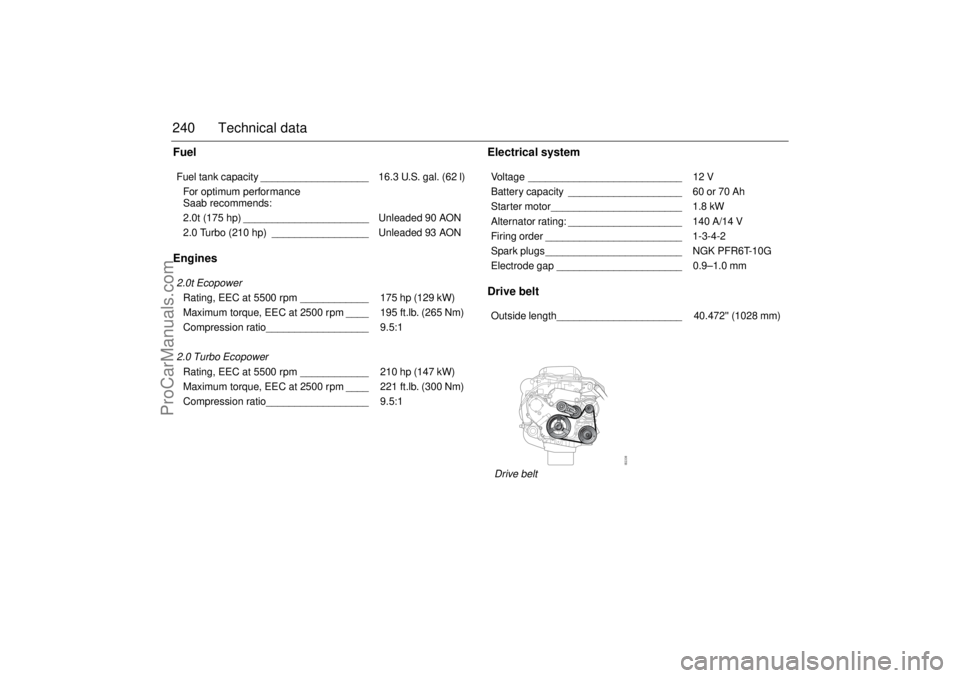SAAB 9-3 2003 Owners Manual
Manufacturer: SAAB, Model Year: 2003, Model line: 9-3, Model: SAAB 9-3 2003Pages: 256, PDF Size: 21.66 MB
Page 231 of 256

231 Maintenance and owner assistance
Engine oil and filter changesChanging the engine oil and filter is required
at every service point. Use only a Saab
approved long-life oil filter and engine oils
meeting the SAE viscosity ratings and API
service classifications stated in the “Techni-
cal data” section of this Owner’s Manual.
The use of extra additives in the oil is not
necessary and is not recommended, and
may be harmful to turbochargers.
More frequent oil changes are recom-
mended if your vehicle is operated under
any of the following conditions:
Most trips are less than 5–10 miles (8–
16 km). This is particularly important
when outside temperatures are below
freezing.
Most trips include extensive idling
(frequent stop-and-go traffic).
Most trips are through dusty areas (such
as construction zones).
If the vehicle is used for delivery service,
police, taxi or other commercial applica-
tions.
If your driving habits match this description,
have the engine oil and filter changed in-
between normal services at 5,000 mile
(8,000 km) intervals. These conditions
cause the engine oil to break down faster.
The Warranties and Service Record Book-
let has provisions to record extra oil
changes.
Service record retentionIt is the owner’s responsibility to retain ser-
vice records. If possible, you should keep
copies of all shop work orders for all service
and repairs, whenever performed. As indi-
cated in the new car and emission control
system warranties, it is important to docu-
ment that all necessary maintenance has
been done.
HOW THE SERVICE RECORD IS ORGA-
NIZED
The service record is comprised of a main-
tenance log and a separate log sheet for list-
ing any additional service and repairs.
There are five coupons at the front of the
section, three of which are for documenting
extra engine oil and filter changes, one for
extra automatic transmission fluid services
necessary for severe service conditions,
one for brake fluid changes and one for
coolant flushes. These are followed by log
sheets for all normal scheduled mainte-
nance in the order it is to be performed,
beginning with the “First Service”.HOW TO USE THE SERVICE RECORD
COUPONS
When the car is brought to a Saab dealer for
scheduled maintenance, present the War-
ranties & Service Record Booklet to the ser-
vice manager. When the technician has
completed the service, the technician will
sign the maintenance record. The person
responsible for quality assurance at the
dealership will also sign and stamp the
record with the dealer identification stamp.
ProCarManuals.com
Page 232 of 256

232 Maintenance and owner assistanceService costsDealer pricing practices and labor for ser-
vice work vary. Saab’s recommended ser-
vice times for each service point do not
include the labor required to replace wear
items, such as wiper blades, brake pads or
tires. Nor is labor to perform other service or
repairs found to be necessary as a result of
the inspections included in these times.
Additional labor and parts will be charged
for such work when necessary, except as
covered under an applicable Saab warranty
or any optional extended service contract.
Transmission fluid changes or suspension
alignment, when necessary, are also addi-
tional.
Dealer charges for general shop material,
regulated hazardous waste removal, recy-
cling expenses or other operation costs may
also be applied to service and repair
invoices and are apt to vary by dealer and
location.
Owner assistanceWarranties and service problem
assistanceFor complete information about all applica-
ble warranties, including the New Car War-
ranty, Perforation Warranty, Vehicle Emis-
sion Warranty and Emission Perforation
Warranty, consult the Warranties and Ser-
vice Record Booklet which accompanies
this Owner’s Manual. It also contains owner
assistance information including Saab
Roadside Assistance. If the booklet is lost or
misplaced, a new one may be ordered
through a Saab dealer or by contacting
Saab.
In the U.S. there is a national Customer
Assistance Center at Saab Cars USA, Inc.
The toll-free number to call from all 50 states
is 1-800-955-9007.
In Canada, please call the Saab Customer
Assistance Centre at 1-800-263-1999.
A list of authorized Saab sales and service
dealers is available for those planning to
travel in the United States and Canada.
Canadian or U.S. travelers may call the
Customer Assistance Center in the country
in which they are traveling.
Change of Address Notification
(U.S. and Canada)Two change of address cards are provided
at the end of the Warranties and Service
Record Booklet. Knowing your current
address allows Saab to contact you in the
event of a recall or service campaign.
Please help us keep our records up to date
for your own peace of mind.Service informationFactory Service Manuals for the Saab 9-3
and 9-5 car lines can be ordered through the
dealer. These are comprehensive manuals
on CD rom, geared to use by professional
technicians.
Consult your Saab dealer for prices for your
model.
ProCarManuals.com
Page 233 of 256

233 Maintenance and owner assistance
Reporting Safety
Defects (U.S.A.)If you believe that your vehicle has a defect
which could cause a crash or could cause
injury or death, you should immediately
inform the National Highway Traffic Safety
Administration (NHTSA) in addition to noti-
fying Saab Cars USA, Inc.
If NHTSA receives similar complaints, it
may open an investigation, and if it finds that
a safety defect exists in a group of vehicles,
it may order a recall and remedy campaign.
However, NHTSA cannot become involved
in individual problems between you, your
dealer, or Saab Cars USA, Inc.
To contact NHTSA, you may either call the
Auto Safety Hotline toll-free at 1-800-424-
9393 (or 202/366-0123 in Washington D.C.
area) or write to: NHTSA, U.S. Department
of Transportation, Washington, D.C. 20590.
You can also obtain other information about
motor vehicle safety from the Hotline.
Reporting Safety
Defects to the Canadian
governmentIf you live in Canada, and believe that your
vehicle has a safety defect, you should
immediately notify Transport Canada, in
addition to notifying General Motors of
Canada Limited.
You may write to Transport Canada at Box
8880, Ottawa, Ontario, K1G 3J2.
In addition to notifying Transport Canada in
a situation like this, we certainly hope you
will notify us. In Canada, please call our
Saab Customer Assistance Centre at 1-
800-263- 1999.
Or write:
General Motors of Canada Limited
Customer Assistance Centre,
1908 Colonel Sam Drive,
Oshawa, Ontario, L1H 8P7.
ProCarManuals.com
Page 234 of 256

234 Maintenance and owner assistance
ProCarManuals.com
Page 235 of 256

235 Technical data
General particulars _____ 236
Engine _______________ 238
Engine oil _____________ 238
Fuel__________________ 240
Engines ______________ 240
Electrical system_______ 240
Drive belt _____________ 240
Manual transmission ___ 241
Automatic transmission _ 241
Suspension ___________ 242
Steering ______________ 242
Brake system__________ 242
Wheels and tires _______ 243
Plates and labels _______ 246
Technical data
ProCarManuals.com
Page 236 of 256

236 Technical dataGeneral particularsOverall length, including bumpers: ______ 182.3'' (4630 mm)
Overall width, including door mirrors _____ 80.2'' (2038 mm)
Maximum height ____________________ 56.9'' (1445 mm)
Wheelbase ________________________ 105.3'' (2675 mm)
Tr a c k :
Front ____________________________ 59.8'' (1520 mm)
Rear ____________________________ 59.3'' (1506 mm)
Ground clearance at GVW ____________ approx. 120 mm
Number of seats (incl. driver) __________ 5
Turning circle:
Measured at vehicle extremities _______ 37.4 ft. (11.4 m)
Curb to curb ______________________ 35.4 ft. (10.8 m)
Permissible load (in addition to the driver) = GVW minus curb weight. The maximum
permissible axle load, front or rear, must not be exceeded.
The precise curb weight of the vehicle (weight ready for driving + driver á 154 lbs.
(70 kg) and load capacity are specified in the vehicle registration documents.V.I.N. plateTrunk length:
Rear seat raised ___________________ 40.8'' (1036 mm)
Rear seat lowered _________________ 69.8'' (1774 mm)
Trunk volume (SAE) _________________ 15.0 cu.ft. (425 l )
ProCarManuals.com
Page 237 of 256

237 Technical data
Curb weight
(i.e. with full fuel tank, full washer fluid res-
ervoir, standard tools and spare wheel) _3174–3461 lbs.
(1440–1570 kg)
Gross vehicle weight (GVW) ___________ 4343–4453 lbs.
(1970–2020 kg)
Maximum axle load:
Front ____________________________ 248 lbs. (1125 kg)
Rear ____________________________ 2226 lbs. (1010 kg)
Weight distribution:
Curb weight + driver (154 lbs. (70 kg)),
front/rear _________________________ approx. 60/40 %
GVW, front/rear ____________________ approx. 50/50 %
Maximum roof load _________________ 220 lbs. (100 kg)
Maximun load in trunk ______________ 175 lbs. (80 kg)
WARNING
The GVW and maximum axle loads must not be exceeded.
Note that if some accessories (e.g. towbar, CD changer) are
fitted, the available load capacity is reduced by the weight of
these.
When carrying a load in the trunk, make sure that it is lashed
down securely, particularly when part or all of the rear seat is
folded down.
Trailer:
Trailer with brakes ___________________ Max. 3500 lbs.
(1588 kg)
Trailer without brakes ________________ Max. 1000 lbs.
(450 kg)
Recommended towball load ___________ 110–165 lbs.
(50–75 kg)
Maximum theoretical towing speed, trailer
with brakes _______________________ 60 mph (100 km/h)
When towing a trailer, increase the pressure
of the rear tires by 0.2 bar (3 psi).
The above speed and weight restrictions are those specified by
Saab Automobile AB.
Note that national restrictions may apply to trailer speeds and
weights (see page 157).
ProCarManuals.com
Page 238 of 256

238 Technical dataEngine Engine oilType: Four cylinders,
double overhead
camshafts,
16 valves, two
balancer shafts,
dual-mass flywheel
Cylinder bore_______________________ 3.386'' (86 mm)
Stroke ____________________________ 3.386'' (86 mm)
Swept volume ______________________ 122 cu.in. (1.998 l)
Idling speed________________________ 670 rpm
Antifreeze _________________________ Saab-approved
antifreeze
Coolant capacity ____________________ 7.5 qts. (7.1 l)
Oil grade
:
We recommend the use of Saab or Mobile oils, available from
you Saab dealer, for regular oil changes.
These oils are specially developed from high-quality compo-
nents to meet the demands of extended service intervals (max.
18,000 miles (30,000 km) or 2 years). Saab and Mobil oils are
tested and approved in accordance with the GM standard for
long-life oils. Such gasoline engine oils are given the designa-
tion GM-LL-A 025. The requirements are the same for diesel
oils, though these are given the designation GM-LL-B 025.
To ensure optimum engine performance, with regard to lu-
brication, the ability to dissolve residues and the neutrali-
sation of combustion products in the oil, for a service
interval of 18,000 miles (30,000 km) or a maximum of
2 years, the engine oil used must fulfil GM-LL-A 025 (gaso-
line engines) or GM-LL-B 025 (diesel engines).
Only oil of the above grades may be used.
Oils of the above grades contain the additives required for
the engine to function well. We advise against the use of
further additives.
The gasoline engine oil is unique in that not only does it fulfil the
stringent requirements demanded by API and ACEA standards
but also meets ACEA requirements for fuel-saving properties.
ProCarManuals.com
Page 239 of 256

239 Technical data
Other grade classifications:API and ACEA designations can also be found on the packag-
ing alongside the GM designations GM-LL-A 025 and
GM-LL-B 025. Oil for gasoline engines classified in accordance
with API standards (American Petroleum Institute) can include
SH (since 1993), SJ (since 1996) and SL (from 2001) classes.
SL class oils fulfil the most stringent requirements. These grade
classes are most often combined with the corresponding class-
es for diesel engines. The class designations for diesel engines
begin with the letter "C" (Commercial). For example, a grade
combination suitable for both types of engine could be API SJ/
CF or SL/CF.
Under ACEA nomenclature, oils are divided into Class A for
petrol engines and Class B for diesel engines. There is a further
class for heavy diesel engines. Each class is divided into
three or four (diesel) grades where grades 2 and 3 (diesel: 4)
normally encompass products comprising semi and fully-
synthetic components.
In the same way as in the API system, gasoline and diesel en-
gine specifications are combined for products that can be used
in both types of engine. For example, a grade designation could
be ACEA A2/B2 or ACEA A3/B3-B4.
Viscosity:
The viscosity of oil is classified according to the SAE standard
(SAE: Society of Automobile Engineers). Nowadays, multigrade
oils are always used in cars. The properties of these oils facili-
tate starting the car in cold weather but mean that the oil is also
sufficiently viscous to coat all moving parts under all operating
conditions.
Multigrade oils are graded with two viscosities, e.g. 0W-30,
where the 0W meets certain viscosity requirements at –22°F (–
30°C), while the 30 fulfils requirements at a temperature of
212°F (100°C).
The approved gasoline engine oil, GM-LL-A 025, has a vis-
cosity of SAE 0W-30.
Oil capacity, including filter (oil change) __ 6.3 qts. (6.0 l)
ProCarManuals.com
Page 240 of 256

240 Technical dataFuel
EnginesElectrical system
Drive belt
Fuel tank capacity ___________________ 16.3 U.S. gal. (62 l)
For optimum performance
Saab recommends:
2.0t (175 hp) ______________________ Unleaded 90 AON
2.0 Turbo (210 hp) _________________ Unleaded 93 AON2.0t EcopowerRating, EEC at 5500 rpm ____________ 175 hp (129 kW)
Maximum torque, EEC at 2500 rpm ____ 195 ft.lb. (265 Nm)
Compression ratio__________________ 9.5:12.0 Turbo EcopowerRating, EEC at 5500 rpm ____________ 210 hp (147 kW)
Maximum torque, EEC at 2500 rpm ____ 221 ft.lb. (300 Nm)
Compression ratio__________________ 9.5:1Voltage ___________________________ 12 V
Battery capacity ____________________ 60 or 70 Ah
Starter motor_______________________ 1.8 kW
Alternator rating: ____________________ 140 A/14 V
Firing order ________________________ 1-3-4-2
Spark plugs________________________ NGK PFR6T-10G
Electrode gap ______________________ 0.9–1.0 mm
Outside length______________________ 40.472'' (1028 mm)
Drive belt
ProCarManuals.com